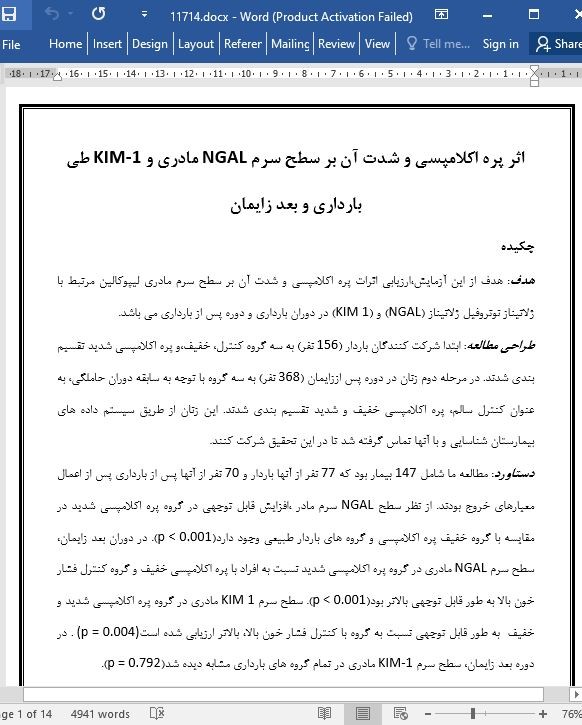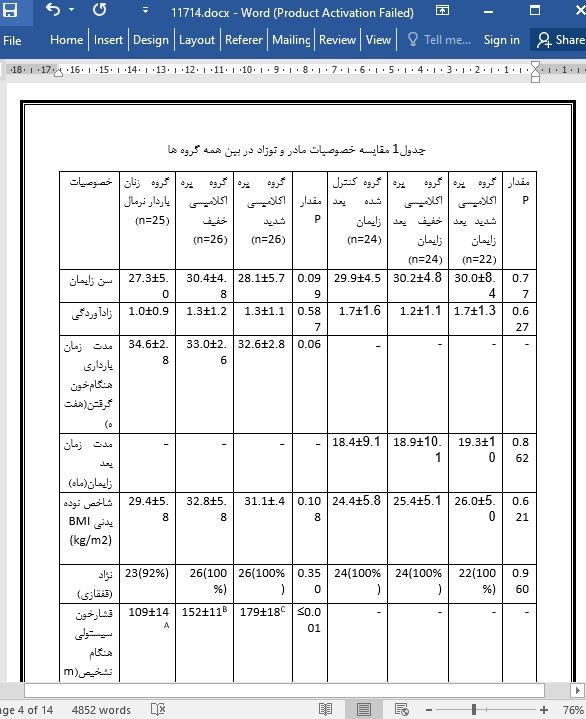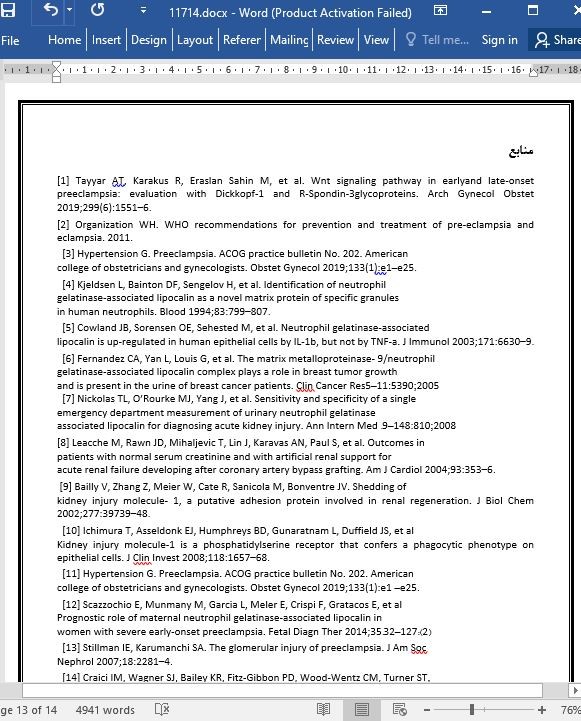
اثر پره اکلامپسی و شدت آن بر سطح سرم NGAL مادری و KIM-1 طی بارداری و بعد زایمان
چکیده
هدف: هدف از این آزمایش،ارزیابی اثرات پره اکلامپسی و شدت آن بر سطح سرم مادری لیپوکالین مرتبط با ژلاتیناز نوتروفیل ژلاتیناز (NGAL) و (KIM 1) در دوران بارداری و دوره پس از بارداری می باشد.
طراحی مطالعه: ابتدا شرکت کنندگان باردار (156 نفر) به سه گروه کنترل، خفیف،و پره اکلامپسی شدید تقسیم بندی شدند. در مرحله دوم زنان در دوره پس اززایمان (368 نفر) به سه گروه با توجه به سابقه دوران حاملگی، به عنوان کنترل سالم، پره اکلامپسی خفیف و شدید تقسیم بندی شدند. این زنان از طریق سیستم داده های بیمارستان شناسایی و با آنها تماس گرفته شد تا در این تحقیق شرکت کنند.
دستاورد: مطالعه ما شامل 147 بیمار بود که 77 نفر از آنها باردار و 70 نفر از آنها پس از بارداری پس از اعمال معیارهای خروج بودند. از نظر سطح NGAL سرم مادر ،افزایش قابل توجهی در گروه پره اکلامپسی شدید در مقایسه با گروه خفیف پره اکلامپسی و گروه های باردار طبیعی وجود دارد(p < 0.001). در دوران بعد زایمان، سطح سرم NGAL مادری در گروه پره اکلامپسی شدید نسبت به افراد با پره اکلامپسی خفیف و گروه کنترل فشار خون بالا به طور قابل توجهی بالاتر بود(p < 0.001). سطح سرم KIM 1 مادری در گروه پره اکلامپسی شدید و خفیف به طور قابل توجهی نسبت به گروه با کنترل فشار خون بالا، بالاتر ارزیابی شده است (p = 0.004). در دوره بعد زایمان، سطح سرم KIM-1 مادری در تمام گروه های بارداری مشابه دیده شد(p = 0.792).
نتایج: دستاوردهای ما نشان می دهد که هرچه شدت پره اکلامپسی افزایش یابد، آسیب کلیه، همانطور که با استفاده از سطح NGAL ارزیابی می شود، برای مدت زمان طولانی حتی در دوران پس از بارداری نیز ادامه دارد.
مقدمه
پره اکلامپسی (pre-eclampsia) که ابتدا از جفت جنین نشات می گیرد و سپس تمام بدن مادر و جنین را تحت تاثیر قرار می دهد، اختلال دوران بارداری محسوب و اغلب در 5درصد افراد دنیا دیده می شود[1]. علی رغم پیشرفت های پزشکی مدرن، پره اکلامپسی از مهم ترین فاکتور های بیماری و مرگ و میر در مادر و جنین او می باشد[2]. اینکه پره اکلامپسی چگونه رخ می دهد، ناشناخته مانده است اما از لحاظ بالینی بدون علامت است و می تواند باعث زوال سایر ارگان ها شود[3]. ادم، ایسکمی، نقص عملکردی در اندوتلیال و وازو اسپاسم-که همه ی ارگان ها را تحت تاثیر قرار می دهد- از عوارض پره اکلامپسی می باشد[3].
محدودیت های مطالعه
در مطالعه ما محدودیت ها و نقاط قوت وجود داشت.اگرچه اندازه نمونه با انجام تجزیه و تحلیل توان تعیین شد، اما اندازه کوچک نمونه مورد استفاده در مطالعه ما محدودیت در نظر گرفته شد. عدم وجود سطح KIM 1 و NGAL در ادرار می تواند یکی دیگر از محدودیت های مطالعه باشد. برای تعیین دوره بهبودی آسیب کلیه بهتر بود که برای دوره بعد از زایمان مدت زمان بیشتری در نظر گرفته شود.
یکی از اهداف این مطالعه تعیین این بود که آیا اثرات طولانی مدت پره اکلامپسی در زنان پس اززایمان وجود دارد یا خیر اما استفاده از گروه های جداگانه از زنان باردار و پس از زایمان، تنوع زیادی را بین افراد قبل و بعد ایجاد می کند. یک طرح بسیار قوی تر این است که سه گروه در دوران بارداری تقویت شده و سپس 6-12 ماه پس از زایمان فرزند خود با این زنان تماس گرفته شود. با این حال، ما می خواستیم اثر پره اکلامپسی را در مدت زمان طولانی تری نشان دهیم، و به خصوص برای این منظور، می خواستیم آن را با شرکت کنندگانی نشان دهیم که بعد از بارداری درگیر با پره اکلامپسی مجددا بارداری ندارند و کلیه آنها به دلیل یک اختلال تحت تاثیر نیست. برای یک مطالعه طولانی تر و گسترده تر، ما نمی توانیم تضمین کنیم که زنان باردار در گروه پره اکلامپسی دوباره باردار نخواهند شد و در اثر بیماری موثر بر کرمین، زمان بهبودی کلیه آسیب نمی بینند. برای یک مطالعه طولانی تر و گسترده تر، ما نمی توانیم تضمین کنیم که زنان باردار در گروه پره اکلامپسی دوباره باردار و دچار اختلال کلیوی نخواهند شد.
Abstract
Objective: The purpose of this trial was to appraise the effects of preeclampsia and its intensity on maternal serum neutrophil gelatinase-associated lipocalin (NGAL) and kidney injury molecule-1 (KIM-1) levels during pregnancy and the post-pregnancy period.
Study design: Firstly pregnant participants (n = 156) were separated into three groups, as control, mild, and severe preeclampsia. Secondly women in post-pregnancy period (n = 368) were separated into three groups according to history of pregnancy, as healthy control, mild, and severe preeclampsia. These women were identified through the hospital data system and contacted by telephone to participate in the study.
Results: Our study comprised 147 patients, 77 of whom were pregnant and 70 of whom were in their postpregnancy period after the exclusion criteria had been applied. In terms of maternal serum NGAL levels, there is a significant increase in the severe preeclampsia group compared with that in the mild preeclampsia and normal pregnancy groups (p < 0.001). During the post-pregnancy period, the maternal serum NGAL levels were found significantly higher in the severe preeclampsia group than in the mild preeclampsia group and non-hypertension control group (p < 0.001). Maternal serum KIM-1 levels were found as significantly higher in the severe and mild preeclampsia groups than in the non-hypertension pregnancy group (p = 0.004). During the post-pregnancy period, maternal serum KIM-1 levels were found as similar among all post pregnant groups (p = 0.792).
Conclusions: Our results indicated that as the severity of preeclampsia increases, kidney damage as assessed using NGAL levels continues for a long period of time, even during the post-pregnancy period.
Introduction
Preeclampsia, which launches in the placenta at first and then affects all mother body and her baby, is a pregnancy disorder and is seen at about 5% frequency in the world [1]. One of the most important morbidity and mortality factors in terms of mother and her baby is the preeclampsia, in spite of the advances in modern medicine [2]. It remains unknown how preeclampsia occurs, but asymptomatic clinical signs may lead to the deterioration of several organs [3]. Edema, ischemia, endothelial dysfunction, and vasospasm, which affect all organs, are consistent with preeclampsia [3].
Study limitations
There were both limitations and strengths to our study. Although the sample size was determined by conducting a power analysis, the small size of the sample used in our study was considered to be a limitation. Absence of urinary KIM-1 and NGAL levels can be another limitation of study. It would have been better to fo the post-pregnancy period for a longer period of time to determine the recovery time of kidney damage.
One aim of the study was to determine whether there were lingering effects of preeclampsia in the post-pregnancy women but using separate groups of women pregnancy and post-pregnancy introduces much inter-individual variation between the pre and post groups. A much stronger design would be to recruit the three groups during pregnancy then to re-contact these women 6–12 months after delivery of their child; however, we wanted to show the effect of preeclampsia in a longer period of time, and especially for this purpose, we wanted to show it with the participants who do not have pregnancy again after pregnancy complicated by preeclampsia and were not complicated by a disease affecting the kidney. For a longer and broader study, we could not guarantee that pregnant women in the preeclampsia group would not conceive again and would not be complicated by a disease affecting the krmine the recovery time of kidney damage.
چکیده
مقدمه
اجزا و روش ها
جمعیت و معیارهای ورود و خروج مطالعه شود
تجزیه و تحلیل بیوشیمی
تجزیه و تحلیل آماری
دستاورد ها
بررسی
نتایج
محدودیت های مطالعه
در دسترس بودن داده ها
منابع
Abstract
Introduction
Materials and methods
Study population and inclusion and exclusion criteria
Biochemical analysis
Statistical and power analyses
Results
Discussion
Conclusion
Study limitations
References
- اصل مقاله انگلیسی با فرمت ورد (word) با قابلیت ویرایش
- ترجمه فارسی مقاله با فرمت ورد (word) با قابلیت ویرایش، بدون آرم سایت ای ترجمه
- ترجمه فارسی مقاله با فرمت pdf، بدون آرم سایت ای ترجمه



